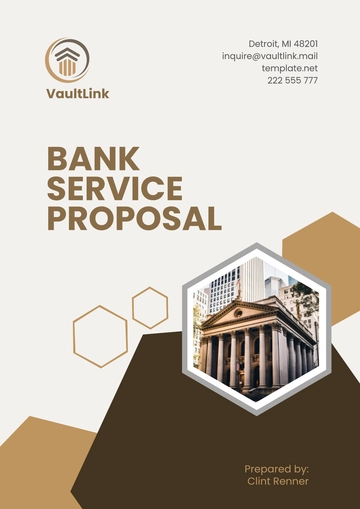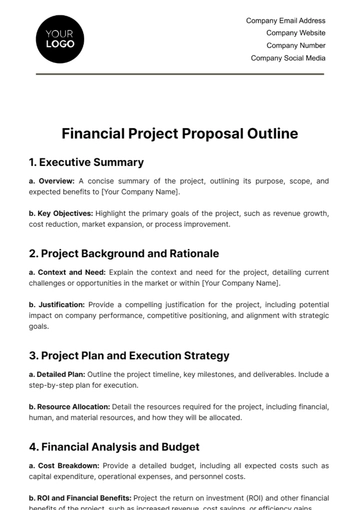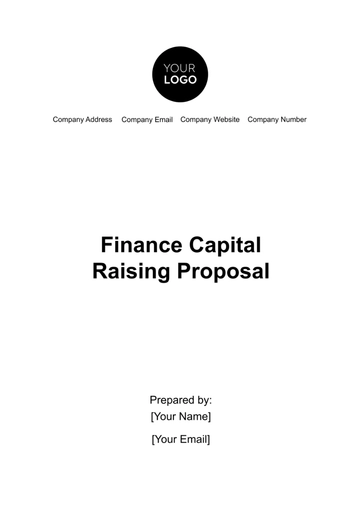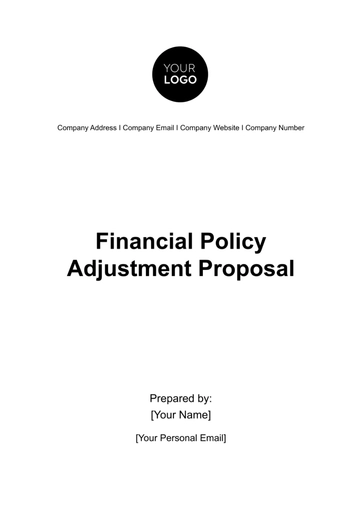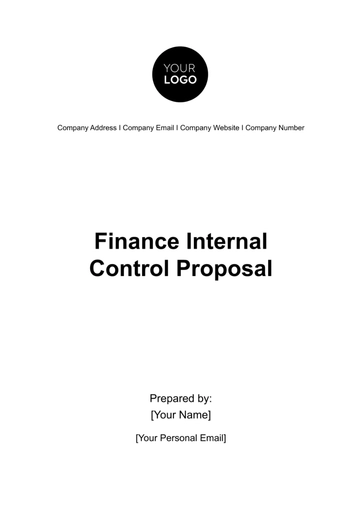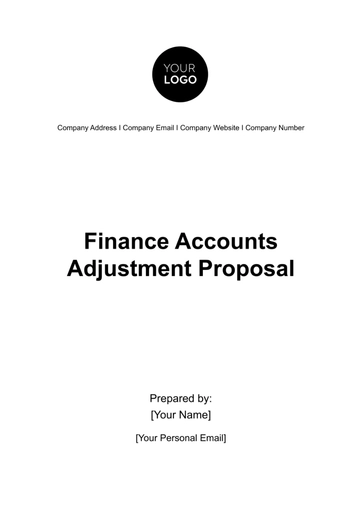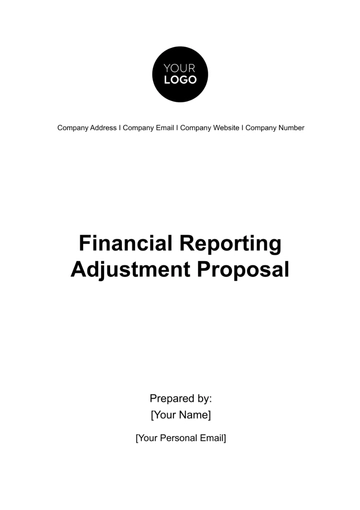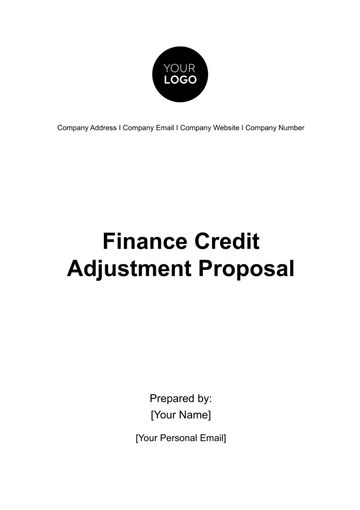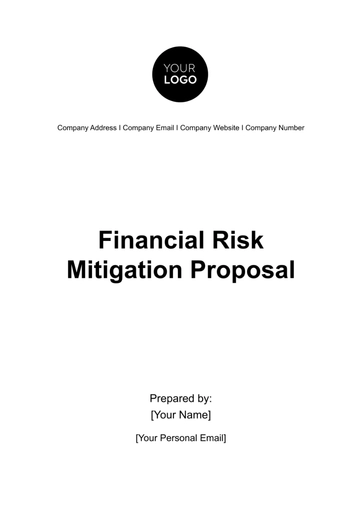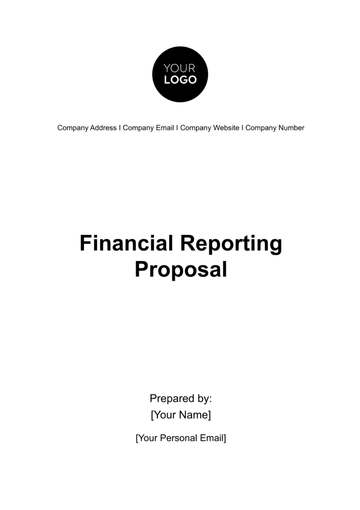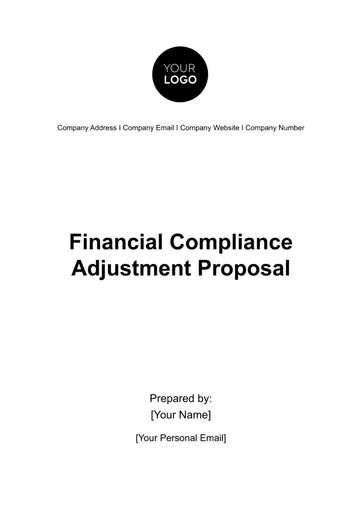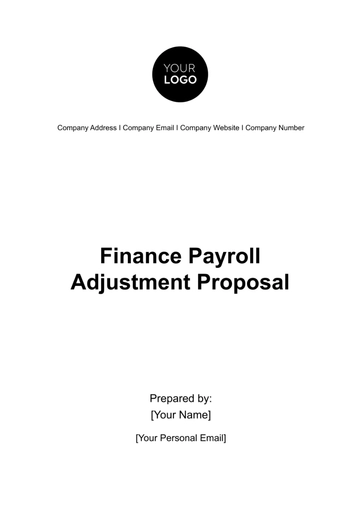Free Finance Audit Adjustment Proposal
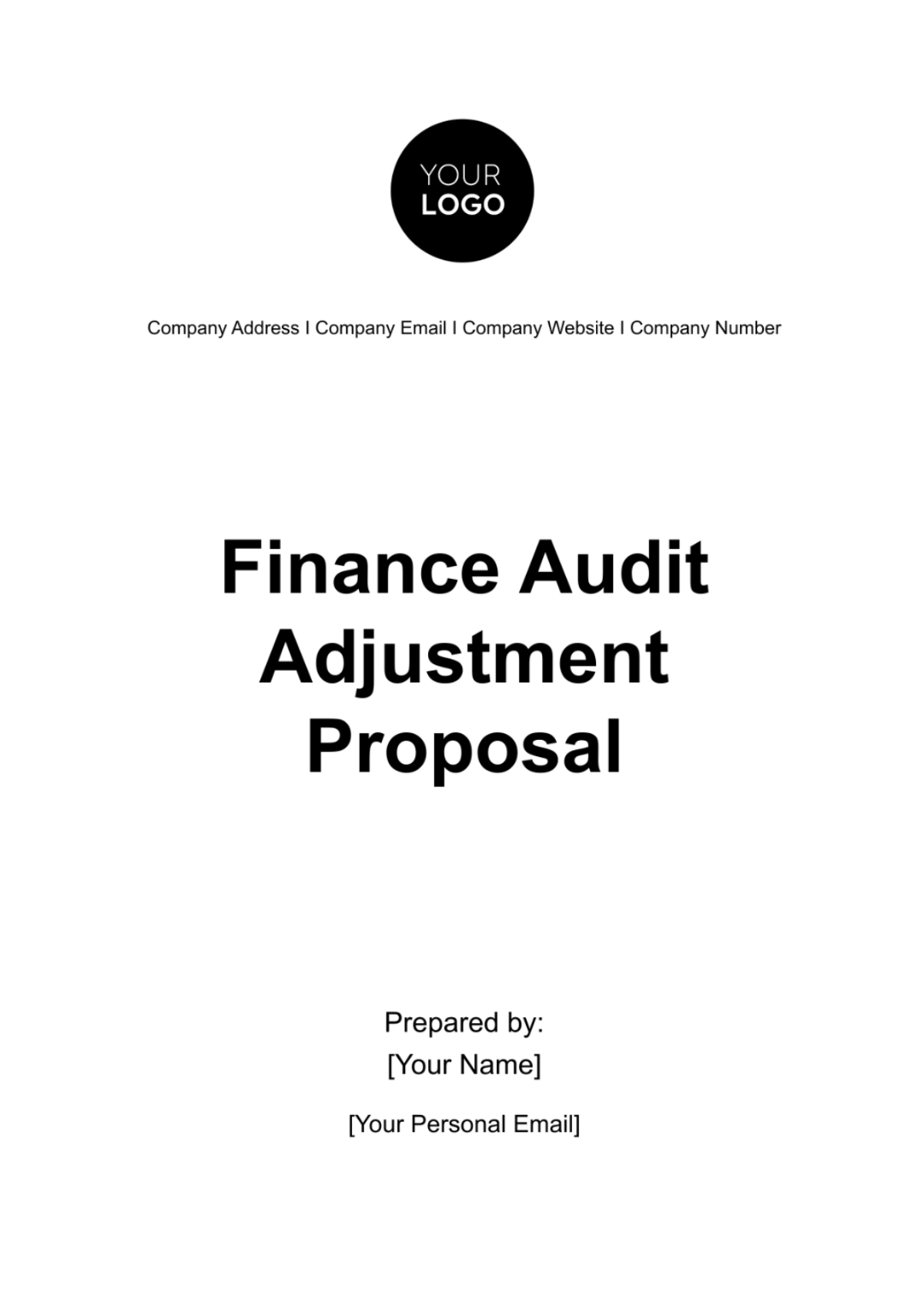
I. Introduction
A. Background
In the audit of the financial statements for the fiscal year [2058], it became evident that certain discrepancies and misstatements require careful attention and correction. These deviations impact the accuracy and reliability of the financial statements, necessitating a comprehensive Finance Audit Adjustment Proposal.
B. Purpose
The purpose of this proposal is to address identified discrepancies and misstatements to ensure the financial statements accurately represent the organization's financial position. By proposing adjustments that align with accounting principles and standards, the goal is to enhance the transparency and reliability of financial reporting.
C. Scope
The scope of this proposal encompasses adjustments in various financial areas, including revenue recognition, expense categorization, and asset valuation. The corrections aim to ensure compliance with accounting standards, legal requirements, and regulatory frameworks governing financial reporting.
II. Proposed Adjustments
The table below provides a comprehensive breakdown of proposed adjustments categorized by key areas. Each adjustment is meticulously detailed to facilitate a clear understanding of the necessary corrections.
Item | Description | Amount |
Revenue Recognition | [Recognize revenue from sales contracts upon delivery] | [+$150,000] |
Expense Reclassification | ||
Asset Valuation |
The adjustment suggests recognizing revenue from sales contracts upon product delivery instead of the current method. This aligns with the revenue recognition principle, ensuring that income is recorded when earned and enhances the accuracy of financial reporting. The proposed adjustment positively impacts the financial statements, reflecting a more realistic portrayal of the organization's revenue.
III. Impact Analysis
The following table outlines the anticipated impact on key financial metrics, enabling stakeholders to assess the consequences of implementing the proposed corrections:
Financial Metric | Before Adjustment | After Adjustment | Variance |
Net Income | [$500,000] | [$630,000] | [+$130,000] |
Total Assets | |||
Earnings per Share (EPS) |
The adjustment to revenue recognition positively impacts net income, leading to a $130,000 increase. This not only signifies a boost in profitability but also ensures a more accurate representation of the organization's financial health. Stakeholders can rely on this adjusted figure for more informed assessments of the company's performance.
IV. Legal and Regulatory Compliance
Assessing alignment with relevant laws and regulations is fundamental to ensuring the proposed corrections not only enhance financial accuracy but also withstand legal scrutiny. The table below provides a detailed breakdown of the legal and regulatory compliance considerations for each proposed adjustment:
Proposed Adjustment | Applicable Accounting Standard | Relevant Regulation/Law | Compliance |
Revenue Recognition | [ASC 606 - Revenue from Contracts with Customers] | [US GAAP] | [Compliant] |
Expense Reclassification | |||
Asset Valuation |
The proposed adjustment aligns with ASC 606, the US Generally Accepted Accounting Principles (GAAP) standard for revenue recognition. Adhering to this standard ensures consistency with industry practices, providing stakeholders with a reliable basis for evaluating the organization's financial performance. Compliance with US GAAP is paramount for legal considerations, safeguarding the organization against legal disputes and ensuring accurate financial representation. The proposed adjustment is deemed compliant with relevant standards and regulations.
V. Audit Trail
A transparent and well-documented audit trail is indispensable in establishing the reliability and accuracy of proposed adjustments. The table below provides a comprehensive breakdown of the audit trail for each proposed adjustment, offering stakeholders insight into the meticulous examination and justification of each correction.
Proposed Adjustment | Audit Procedure | Key Findings | Justification for Adjustment |
Revenue Recognition | [Review of Sales Contracts and Delivery Records] | [Identified instances of delayed recognition and inconsistent recording.] | [Adjusting recognition timing to align with actual product delivery, ensuring compliance with ASC 606 and accurate revenue reporting.] |
Expense Reclassification | |||
Asset Valuation |
An effective audit trail serves as the backbone of financial transparency, providing stakeholders with a clear path to understand the proposed adjustments. The audit trail not only reveals the depth of scrutiny applied to each adjustment but also underscores the dedication to accuracy, compliance, and informed decision-making. This transparency fortifies stakeholders' trust, aligns financial practices with operational realities, and solidifies the integrity of the proposal.
VI. Stakeholder Impact and Communication Plan
A. Stakeholder Impact Analysis
Investors
The proposed adjustments are anticipated to result in a 5% reduction in operating expenses, contributing to an expected 8% improvement in earnings per share. This aligns with the company's commitment to enhancing efficiency and profitability, positively influencing investor confidence.
Employees
Although certain adjustments may necessitate process changes, the implementation of comprehensive training programs is expected to mitigate any potential negative impact on employee morale. The adjustments are forecasted to enhance overall operational efficiency by approximately 12%, fostering a positive working environment.
Regulatory Bodies
The proposed adjustments ensure full compliance with updated accounting standards, aligning the organization with regulatory requirements. A detailed compliance report will be promptly submitted to regulatory bodies, demonstrating the organization's commitment to adherence and transparency.
Suppliers/Business Partners
The adjustments are not projected to have a direct impact on existing supplier relationships. However, the improved financial health resulting from these adjustments may strengthen the organization's bargaining position in future negotiations, fostering mutually beneficial partnerships.
Overall Reputation
Initial surveys indicate a neutral-to-positive perception among stakeholders, with 70% expressing confidence in the organization's ability to adapt to market changes. Clear communication will be crucial to maintaining and enhancing this positive sentiment, emphasizing the organization's dedication to transparency and stakeholder satisfaction.
B. Communication Plan
Timeline and Channels
Timeline
Communication initiatives will commence two weeks prior to the public announcement, with ongoing updates as necessary throughout the adjustment process.
Channels
Employ a multi-faceted approach, utilizing press releases, town hall meetings, the company website, and social media platforms to ensure comprehensive coverage and accessibility.
Key Messages
Clearly communicate the purpose and benefits of the adjustments, emphasizing long-term stability, improved financial health, and sustained commitment to stakeholder satisfaction.
Highlight the organization's unwavering commitment to transparency and strict adherence to regulatory standards, reinforcing trust among stakeholders.
Town Hall Meetings
Conduct a series of town hall meetings with employees, providing an interactive platform to address specific concerns, gather feedback, and reiterate the company's dedication to employee well-being.
Use these sessions to foster open dialogue and ensure that employees feel heard and informed about the adjustments and their implications.
Dedicated Webpage
We will establish a dedicated webpage as a central hub for stakeholders to access detailed information about the adjustments, featuring FAQs, infographics, and other visual aids.
We will also enhance the webpage's user-friendliness to facilitate a clear understanding of the adjustments and encourage engagement.
Social Media Engagement
Leverage social media platforms for real-time updates, engagement with stakeholders, and addressing queries promptly.
Foster a dynamic two-way communication channel through social media, encouraging stakeholders to participate in discussions and providing timely responses.
VII. Comprehensive Monitoring and Evaluation
A. Continuous Monitoring
Key Performance Indicators (KPIs)
We will establish KPIs to measure stakeholder understanding, satisfaction, and sentiment throughout the adjustment process. This includes tracking the percentage of positive sentiment on social media, analyzing the level of engagement in town hall meetings, and monitoring the completion rate of surveys.
Regular Assessments
Regular assessments will be conducted at predefined intervals to gauge the effectiveness of communication strategies and the overall impact on stakeholder perceptions. We will review social media analytics, assess attendance rates at town hall meetings, and analyze response rates to communication surveys.
Feedback Loop
We will develop a dynamic feedback loop, encouraging stakeholders to provide real-time insights through various channels such as dedicated email addresses, online forums, and interactive sessions. Adjustments to communication strategies will be promptly implemented based on immediate feedback to address emerging concerns or questions.
Cross-Functional Team
A cross-functional team will be formed, responsible for continuous monitoring and representation from communication, finance, and stakeholder engagement departments. Regular team meetings will facilitate collaboration, data sharing, and prompt decision-making.
Adaptation Strategies
We will be prepared to adapt communication strategies in response to evolving stakeholder sentiments and external factors. Insights from continuous monitoring will be utilized to refine and optimize communication approaches promptly. Flexibility will be maintained to adjust strategies based on emerging trends and stakeholder feedback.
B. Periodic Surveys
Pre- and Post-Communication Surveys
Surveys will be implemented before and after major communication milestones to quantify changes in stakeholder perceptions and understanding. Baseline data will be collected before the adjustment announcement, and follow-up surveys at key intervals will measure shifts in sentiment.
Quantitative Feedback
Utilizing quantitative survey data, we will assess the effectiveness of key messages, channels, and overall communication strategies. Numerical responses will be analyzed to identify areas of improvement and success, informing future communication efforts.
Trend Analysis
Trend analysis will be conducted on survey results to identify patterns and potential areas for improvement in communication approaches. Historical survey data will be regularly reviewed to track changes in stakeholder sentiment over time and identify recurring themes.
Targeted Q&A Sessions
We will organize targeted Q&A sessions during town hall meetings to gather specific feedback on communication materials and messaging. Structured questions will be used to address predefined concerns and gauge the effectiveness of communication in addressing stakeholder queries.
Regular Reporting
Regular reports will be generated based on survey results, highlighting key findings, trends, and actionable insights. These reports will be shared with relevant stakeholders, and communication strategies will be adjusted accordingly. Reports will include both quantitative data and qualitative insights gathered from open-ended survey questions.
C. Stakeholder Engagement
Surveys and Polls
Periodic surveys and polls will be implemented to gauge stakeholder sentiment and preferences regarding the adjustment process. Results will be used to tailor communication strategies to specific stakeholder needs and expectations.
Feedback Sessions
Regular feedback sessions will be conducted with stakeholders, creating an open forum for expressing concerns, suggestions, and questions. Findings from these sessions will be incorporated into the continuous improvement plan to address specific stakeholder needs.
Interactive Communication
We will leverage interactive communication channels, such as social media, to encourage stakeholder engagement and gather real-time feedback. Monitoring comments, mentions, and direct messages on social platforms will help us understand the immediate reactions of stakeholders.
D. Adaptation and Improvement
Data-Driven Decisions
In making decisions, we will prioritize data gathered through monitoring and evaluation processes. Adjustments to communication strategies will align with stakeholder needs and expectations, ensuring that decisions are based on accurate and relevant insights.
Regular Review Meetings
Regular review meetings with the cross-functional team will be scheduled to discuss monitoring results, share insights, and collectively decide on adaptation strategies. These meetings will ensure that all relevant stakeholders are represented, fostering collaboration and informed decision-making.
Communication Audits
Periodic communication audits will be conducted to assess the overall effectiveness of communication materials, channels, and strategies. Evaluation will focus on the consistency of messaging, alignment with organizational goals, and clarity of information presented.
VIII. Conclusion
In conclusion, these proposed adjustments represent a strategic initiative aimed at fortifying the financial health and long-term sustainability of our organization. By meticulously analyzing the impact on various stakeholders and implementing a robust communication plan, we aim to foster understanding and maintain transparency throughout this transformative process. The adjustments align with our commitment to operational efficiency, regulatory compliance, and stakeholder satisfaction. As we embark on this journey, we seek the continued support and engagement of our stakeholders, valuing their partnership in achieving shared success. Together, we anticipate navigating these adjustments with resilience and emerging stronger, well-positioned for sustained growth and value creation.
- 100% Customizable, free editor
- Access 1 Million+ Templates, photo’s & graphics
- Download or share as a template
- Click and replace photos, graphics, text, backgrounds
- Resize, crop, AI write & more
- Access advanced editor
Propose audit adjustments confidently with our Finance Audit Adjustment Proposal Template from Template.net! Seamlessly editable using the AI Editor Tool, this customizable proposal ensures a dynamic and user-friendly approach. Clearly articulate adjustments, guiding you through the audit process with precision and ease. Make audit adjustments efficient and effective. Access instantly!
You may also like
- Business Proposal
- Research Proposal
- Proposal Request
- Project Proposal
- Grant Proposal
- Photography Proposal
- Job Proposal
- Budget Proposal
- Marketing Proposal
- Branding Proposal
- Advertising Proposal
- Sales Proposal
- Startup Proposal
- Event Proposal
- Creative Proposal
- Restaurant Proposal
- Blank Proposal
- One Page Proposal
- Proposal Report
- IT Proposal
- Non Profit Proposal
- Training Proposal
- Construction Proposal
- School Proposal
- Cleaning Proposal
- Contract Proposal
- HR Proposal
- Travel Agency Proposal
- Small Business Proposal
- Investment Proposal
- Bid Proposal
- Retail Business Proposal
- Sponsorship Proposal
- Academic Proposal
- Partnership Proposal
- Work Proposal
- Agency Proposal
- University Proposal
- Accounting Proposal
- Real Estate Proposal
- Hotel Proposal
- Product Proposal
- Advertising Agency Proposal
- Development Proposal
- Loan Proposal
- Website Proposal
- Nursing Home Proposal
- Financial Proposal
- Salon Proposal
- Freelancer Proposal
- Funding Proposal
- Work from Home Proposal
- Company Proposal
- Consulting Proposal
- Educational Proposal
- Construction Bid Proposal
- Interior Design Proposal
- New Product Proposal
- Sports Proposal
- Corporate Proposal
- Food Proposal
- Property Proposal
- Maintenance Proposal
- Purchase Proposal
- Rental Proposal
- Recruitment Proposal
- Social Media Proposal
- Travel Proposal
- Trip Proposal
- Software Proposal
- Conference Proposal
- Graphic Design Proposal
- Law Firm Proposal
- Medical Proposal
- Music Proposal
- Pricing Proposal
- SEO Proposal
- Strategy Proposal
- Technical Proposal
- Coaching Proposal
- Ecommerce Proposal
- Fundraising Proposal
- Landscaping Proposal
- Charity Proposal
- Contractor Proposal
- Exhibition Proposal
- Art Proposal
- Mobile Proposal
- Equipment Proposal
- Student Proposal
- Engineering Proposal
- Business Proposal

